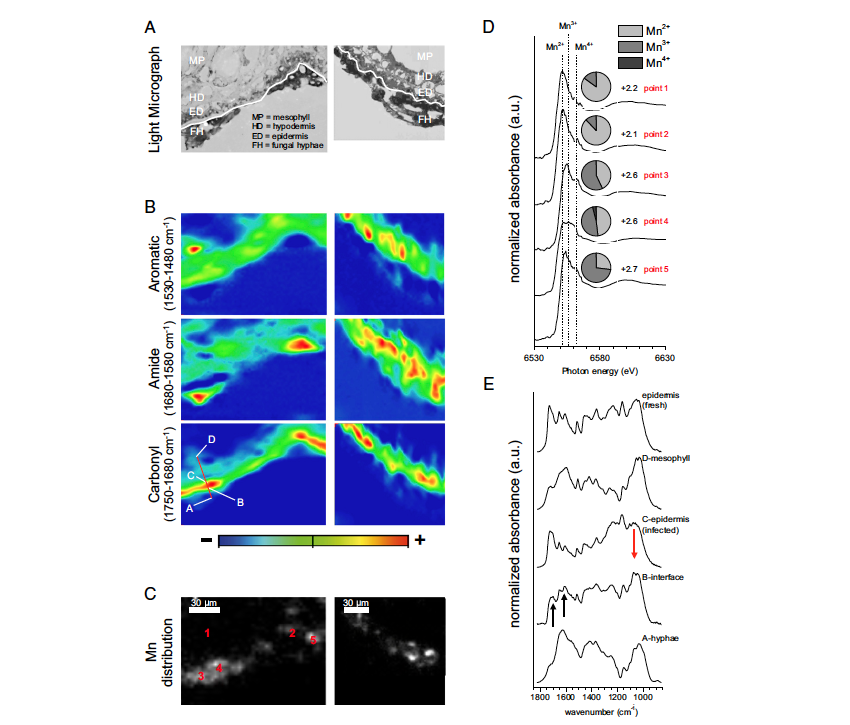Microbial decomposition of plant debris (“litter”) is a keystone ecosystem process because it regulates nutrient availability, ecosystem productivity, and carbon (C) cycling. Historically, climate (primarily temperature and precipitation) has been thought to regulate the rate of litter decomposition, which then influences the rate at which nutrients become available and C contained in the litter is released back into the atmosphere as the greenhouse gas CO2. However, more recently, evidence has shown that there are also geochemical factors that influence litter decomposition rates. A team of researchers from Oregon State University, Lawrence Livermore National Laboratory, Lawrence Berkeley National Laboratory, and Old Dominion University have shown, through work at the ALS, that long-term litter decomposition rates in forest ecosystems are closely related to the process of manganese (Mn) reduction-oxidation (redox).

Out of many possible factors, Mn emerged as a key driver of litter decomposition in a variety of forest ecosystems—ranging from boreal forests in cold climates to semi-arid deciduous forests in warmer climates. A strong correlation has previously been observed between litter Mn content and decomposition rates, but the mechanisms underlying Mn’s role in litter decomposition were not well understood. In redox cycling, Mn is governed by reduction-oxidation (redox) reactions, frequently mediated by microbes. This research showed that microbes accumulate and oxidize Mn in the litter, and then use the oxidized Mn species to break down plant cells.
By pairing high-resolution chemical imaging analysis with a long-term litter decomposition experiment under field conditions, the researchers discovered that litter decomposition is tightly coupled to redox cycling of Mn. Litter decomposition was closely monitored over a seven-year period, providing the unique opportunity to investigate how microbes gradually decompose litter from year to year.
The researchers combined the capabilities of three different beamlines at the ALS to understand why Mn exerts such a strong control on litter decomposition rates and the mechanism of the underlying biogeochemical process. At ALS Beamline 9.0.2, researchers used a post-ionization mass spectrometry technique to look at molecular changes within the litter as it decomposed over the years. Using this soft ionization method meant that the researchers were able to probe structural changes within the very large biomolecules present in litter that are frequently not directly detectable by other means. The technique is also tunable, which allowed the scientists to selectively ionize different biopolymers present in the litter, such as lignin, which is an important biopolymer because it lends rigidity to plant cell walls and protects litter from microbial decay.
The x-ray microprobe capabilities at ALS Beamline 10.3.2 allowed researchers to examine microenvironments within the litter, in which microbes actively cycle Mn as they colonize and break down the litter. This technique was combined with FTIR spectromicroscopy at ALS Beamline 1.4.3, which is very sensitive to changes in the chemical structure of organic compounds (such as lignin) that make up a large portion of the litter. FTIR imaging was able to demonstrate the role of microbes in the decomposition process and how they also use these oxidized Mn species to break down the lignin that protects the remaining plant cell walls. This research indicates that biogeochemical constraints on bioavailability, mobility, and reactivity of Mn in the plant–soil system may have a profound impact on litter decomposition rates. Understanding more about the mobility and reactivity of Mn in the plant-soil system also helps researchers improve their ability to accurately predict carbon cycling trends in ecosystems, contributing to greater insights into climate change patterns.

Contact: Marco Keiluweit
Research conducted by: M. Keiluweit (Oregon State University, Lawrence Livermore National Laboratory), P. Nico (Lawrence Berkeley National Laboratory), M.E. Harmon (Oregon State University), J. Mao (Old Dominion University), J. Pett-Ridge (Lawrence Livermore National Laboratory), and M. Kleber (Oregon State University, ZALF).
Research funding: U.S. Department of Energy (DOE), Office of Basic Energy Sciences (BES) and Howard Hughes Medical Institute. Operation of the ALS is supported by DOE BES.
Publication about this research: M. Keiluweit, P. Nico, M.E. Harmond, J. Maoe, J. Pett-Ridge, and M. Klebera, “Long-term litter decomposition controlled by manganese redox cycling,” PNAS 12, E5253 (2015)
ALS SCIENCE HIGHLIGHT #324